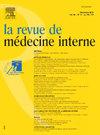[壳三醇苷酶作为结节病血清生物标志物的地位:文献综述]。
IF 0.9
4区 医学
Q3 MEDICINE, GENERAL & INTERNAL
引用次数: 0
摘要
结节病是一种炎症性全身性疾病,以上皮巨细胞肉芽肿病为特征,无细胞坏死。病理诊断。结节病有许多生物标志物。自1975年以来,血管紧张素转换酶(ACE)在常规医学实践中应用最广泛。然而,它是一个低诊断价值的标志。其他最常研究的生物标志物是壳三酸苷酶(CTO)、可溶性IL-2受体(rsIL-2)、新蝶呤、溶菌酶和SAA蛋白。本文就结节病的血清生物标志物进行综述。这些研究是异质的,结果很难得出结论。病理学仍然是最终诊断的金标准。在进化随访和复发的背景下,我们可以选择先验的3个感兴趣的标志物:ACE(敏感性[Se]: 22至77%,特异性[Sp]: 54至99%),CTO (Se: 45至89%,Sp: 70至100%)和rsIL-2 (Se: 52至82%,Sp: 57至94%)。一种特定疾病表型的最合理关联尚未确定。未来的进展将来自对肉芽肿的深入了解,它的形成、生长和消退机制仍然部分未知的炎症和免疫反应。最近通过放射检查取得了实质性进展。多组学技术无疑将补充生理病理和诊断研究的武库,这将使摆脱病理检查成为可能,并确保更好地监测疾病。本文章由计算机程序翻译,如有差异,请以英文原文为准。
Place de la chitotriosidase au sein des biomarqueurs sériques de la sarcoïdose : une revue narrative de la littérature
Sarcoidosis is an inflammatory systemic disease characterized by epithelio-gigantocellular granulomatosis without cell necrosis. The diagnosis is pathologic. There are many biomarkers of sarcoidosis. The oldest and most widely used in routine medical practice is angiotensin-converting enzyme (ACE) since 1975. However, it is a marker of low diagnostic value. The other most frequently studied biomarkers of interest are chitotriosidase (CTO), soluble IL-2 receptor (rsIL-2), neopterin, lysozyme, and SAA protein. In this work, we propose a review of the serum biomarkers of sarcoidosis. The studies are heterogeneous, and the results are difficult to conclude. Pathology remains the gold standard for the definitive diagnosis. In the context of evolutionary follow-up and relapse, we can select a priori 3 markers of interest: ACE (sensitivity [Se]: from 22 to 77% and specificity [Sp]: from 54 to 99%), CTO (Se: from 45 to 89% and Sp from 70 to 100%), and rsIL-2 (Se: from 52 to 82% and Sp: from 57 to 94%). The most rational association for a particular disease phenotype has yet to be determined. Future advances will come from an in-depth knowledge of granuloma, its mechanisms of formation, growth, and regression in the context of a still partially unknown inflammatory and immune response. Recent substantial progress has been made through radiological examinations. Multi-omics technologies will undoubtedly complement the arsenal of physiopathological and diagnostic research that will make it possible to move away from pathological examination and ensure better monitoring of the disease.
求助全文
通过发布文献求助,成功后即可免费获取论文全文。
去求助
来源期刊

Revue De Medecine Interne
医学-医学:内科
CiteScore
0.70
自引率
11.10%
发文量
526
审稿时长
37 days
期刊介绍:
Official journal of the SNFMI, La revue de medecine interne is indexed in the most prestigious databases. It is the most efficient French language journal available for internal medicine specialists who want to expand their knowledge and skills beyond their own discipline. It is also the main French language international medium for French research works. The journal publishes each month editorials, original articles, review articles, short communications, etc. These articles address the fundamental and innumerable facets of internal medicine, spanning all medical specialties. Manuscripts may be submitted in French or in English.
La revue de medecine interne also includes additional issues publishing the proceedings of the two annual French meetings of internal medicine (June and December), as well as thematic issues.
 求助内容:
求助内容: 应助结果提醒方式:
应助结果提醒方式:


